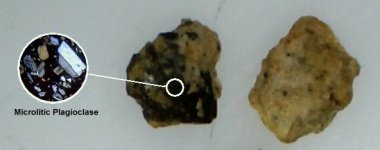Okay, it's time to get to the bottom of this discussion, because everyone is missing points. Bolding mine.
Let's start with predators. A predator can do one of many things.
There are at least three distinct differences. First they can cause a perforation of epithelial cells in the mantle. The surrounding healthy cells will divide/multiply and encapsulate the lesion. An irritant, if you will. Next, a predator or cracked shell can also cause a section of mantle tissue. This is where otherwiswe healthy epithelial cells are displaced elsewhere in the bloodstream, where they continue to divide/multiply. Lastly, although the predator is killed by the host, it's mantle continues to live and grow.
Virtually any material, whether sand, shell, porcelain or even plastic in the epithelial space can give rise to biomineralization and pearls or what we know as mabe or blisters. This process occurs in complete absence of predators and displaced/grafted tissue. Again, it's an irritant that nacre alleviates. Not all extrapallial irritants are fused to the shell. Grains of sand are able to perforate the outer layer of the epithelium and become loose pearls,
provided they are immediately adjacent to healthy epithelial cells.
1- Perforation by parasite.
2- Sectional graft, self donor.
3- Sectional graft, foreign donor.
4- Non predator foreign body, no perforation.
5- Non predator foreign body with perforation.
I've just termed five entirely different processes. It doesn't end there though, because there are numerous infectious blood borne diseases, whether viral, bacterial or auto-immune. Hormonal changes and blood acid/base levels can give rise to spontaneously formed pearls. Infected organs, particularily the gonads or adductor muscles also are known to cause pearls.
6- Viral infection
7- Bacterial infection
8- Auto-immune responses.
That brings us up to at least eight unique combinations to the onset of pearls. The common thread in all cases, pearls are the result of an interaction between calcium ions,
metabolic CO2 and bicarbonate.
Can I prove sand is implicated? Yes. This was fleshed out in my work with Rock Oysters (Pododesmus macrochisma)
The greater portion of the world's sand consist of two things. Basalt and shell fragments. Both have an affinity for biomineralization. In fact, basalt is the foundation upon which everything in the ocean is held fast and propagated. This mineral has a known property, which electrochemically supports bacterial growth by gathering carbon dioxide. A C02 trap, if you will. These are fundamentally the most basic building blocks for life. All living things use calcium, hence calcium carbonate and metabolic carbon dioxide is generated.
From Wikipedia said:
Basalt is a common extrusive igneous (volcanic) rock formed from the rapid cooling of basaltic lava exposed at or very near the surface of a planet or moon. By definition, basalt is an aphanitic igneous rock with less than 20% quartz and less than 10% feldspathoid by volume, and where at least 65% of the feldspar is in the form of plagioclase. (In comparison, granite has more than 20% quartz by volume.)
Basalt is usually grey to black in colour, but rapidly weathers to brown or rust-red due to oxidation of its mafic (iron-rich) minerals into rust. It almost always has a fine-grained mineral texture due to the molten rock cooling too quickly for large mineral crystals to grow, although it can sometimes be porphyritic, containing the larger crystals formed prior to the extrusion that brought the lava to the surface, embedded in a finer-grained matrix.
From Wikipedia said:
Plagioclase is a major constituent mineral in the Earth's crust, and is consequently an important diagnostic tool in petrology for identifying the composition, origin and evolution of igneous rocks.
From Wikipedia said:
The common corrosion features of underwater volcanic basalt suggest that microbial activity may play a significant role in the chemical exchange between basaltic rocks and seawater. The significant amounts of reduced iron, Fe(II), and manganese, Mn(II), present in basaltic rocks provide potential energy sources for bacteria. Recent research has shown that some Fe(II)-oxidizing bacteria cultured from iron-sulfide surfaces are also able to grow with basaltic rock as a source of Fe(II).[8] In recent work at Loihi Seamount, Fe- and Mn- oxidizing bacteria have been cultured from weathered basalts.[9] The impact of bacteria on altering the chemical composition of basaltic glass (and thus, the oceanic crust) and seawater suggest that these interactions may lead to an application of hydrothermal vents to the origin of life.

In the attached images, are two pearls from the outer epithelium of the adductor muscle. Grains of sand and indicated by the presence of microlitic structures of plagioclase at 1500x magnification.
These are not biological in origin. They are the result of volcanic processes. The grain is only partially biomineralized, revealing microlites, while other pearls adjacent to it were entirely encapsulated.
In conclusion, sand is not implicated in cultured pearls. Quite obviously, shell bead nuclei and/or grafted epithelial tissue is. This is where the myth is busted. However,
in natural pearls, sand is implicated with measureable certainty, hence the myth is confirmed. Let us not confuse the two.


